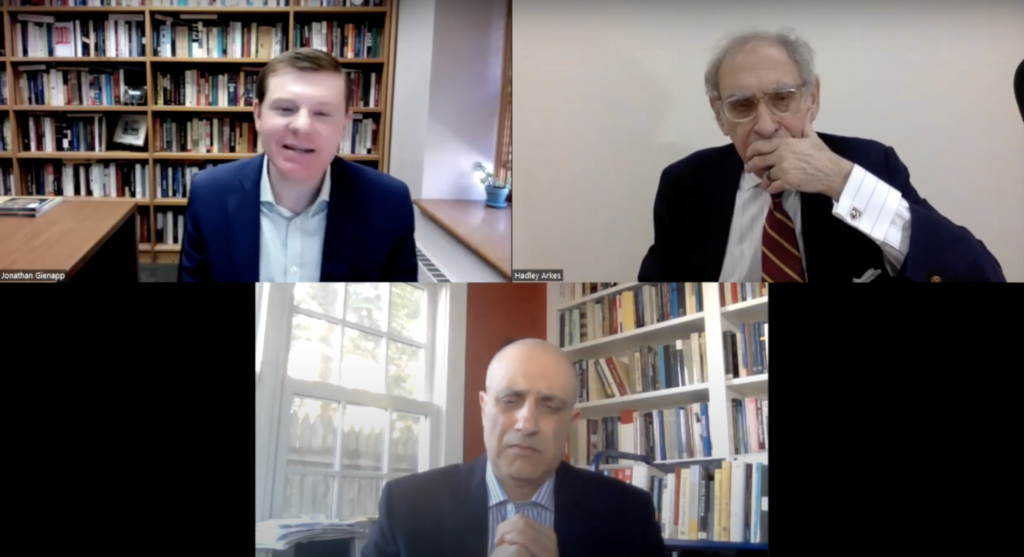
One of the ways I developed an interest in James Wilson (I’d long been interested in him based on my interest in founding era intellectual history) was as I began to try to make sense of how people understood the Constitution when it first appeared and especially the ways they conceived of it. I found few people who spoke to this more perceptively than Wilson, not just in offering his own substantive views on the matter, but in his recognition that there were key questions to be answered.
I found especially revealing what Wilson said about the Constitution during the ratification debates when people are considering whether to approve the work of the Philadelphia Convention. To try to gain a toehold, lots of people in the ratification debates—and this really begins in the Pennsylvania Ratifying Convention because it was the first major state convention—are trying to analogize the Constitution to other kinds of things with which they are more familiar, other instruments of law. Wilson makes this perceptive comment in which he effectively says, “Stop trying to compare the Constitution to those other things, to a treaty or to a statute or what have you. Recognize what it essentially is. It’s a people’s charter, it’s a popular charter and understand what that means.” This observation prompts this long disquisition on popular sovereignty, a topic that had always interested me. What a deep student he was of that concept, which had been around in protean form for some time, but was really just being worked out systematically by the American Revolutionaries. Here Wilson was connecting the novel American concept of popular sovereignty, as he understood it, to a strong argument about what kind of thing the Constitution was, and thus how it ought to be interpreted.
So, I came to Wilson. I was pulled in by the fact that he seemed so conscious of the Constitution’s deeper dimensions, and that’s a big reason why I’ve continued with him. In these preliminary remarks, I want to develop that theme further. Like a lot of people at the time, James Wilson strongly believed that the United States Constitution, like any constitution, was embedded. To understand what the constitution was, to understand what it did, what it required, what it allowed, what it protected was to understand its underlying foundations. And two conceptual contexts or foundations were especially critical to him. Here he’s a master tour guide for understanding the founding more broadly.
The first pertains to the nature of law itself. Like a great many people at the Founding, James Wilson had a very different view of law than tends to prevail today. Like the principles of mathematics, law was understood to be something that was out there: something that was found rather simply made. This was especially true of what was called fundamental law. Law was not simply the contingent construction of human beings. It was not simply positivist in character—something human beings posited. It derived from a different set of sources, each of which offered a crucial foundation for legal reasoning. Natural law was one of the most striking examples of these alternative sources of law, but there were many more still. Even more than this, what I think Wilson helps us understand about founding-era legal thinking is not just that there were deeper legal foundations or that law was found as much as it was made, but also the way in which he understood law itself.
Like a lot of people at the time, Wilson held an integrated view of law. He didn’t like drawing categorical distinctions between sources of law: natural law over here, customary law over there, enacted law over there. He didn’t tend to separate what we might call positive law from what we might call non-positive law. What he instead thought was that law, the different sources and kinds of law one could identify, naturally harmonized. And the study of law was the study of that harmony, how it synthesized—how it all hung together as a coherent whole
John mentioned Wilson’s law lectures, which in published form are arguably the best legal treatise we have from the founding era, but it was one of many such treatises. And one of the most striking things about these sources is that they bear no relationship to legal treatises written today. They seem to draw freely, without any sense that they’re leaving the disciplinary bounds of law, on all sorts of other intellectual subjects that we would refer to as political theory or moral philosophy or sociology or psychology or history. This was part of how John, a cognitive philosopher, made his way to Wilson, there were no sharp intellectual breaks, no sharp disciplinary breaks, for Wilson and his peers between what we might call philosophy and what we might call law or history. To understand law was to understand human nature, to understand human dispositions and the human mind. It was to understand this grand synthesis of human existence and activity and to understand how it all held together. So Wilson, like a lot of jurists said at the time, like a lot of people who thought about this, really tried to understand how natural law, positive law, common law (in both its non-positive and positive forms), and British constitutionalism all harmonized into a single account of general legal principles from which one could reason and interpret about a particular constitution of government. That included not just the US Constitution, but also the Articles of Confederation that preceded it as well as the various state constitutions that had been drawn up starting in 1776. Wilson allows us to not just see different kinds of law, he allows us to glimpse a different conception of law itself and how people living at the founding reasoned about law. And I think it’s very hard to understand constitutionalism in the founding era without recognizing this essential way in which people assumed the Constitution was embedded.
The second conceptual context I’ll just briefly speak to was social compact theory or social contract theory, the ubiquitous idea that the formation of any government involved two steps. These steps were hypothetical, they were imaginary, but they were very much how people at the time made sense of this process. Step one, you leave the state of nature and form a political community or a polity or a people, if you will. And then step two, that people establishes a constitution of government. The fact that there were two distinction steps in this process was so important because the underlying foundation of the social compact, which was beneath the government, was considered an essential feature of the constitution and an essential ingredient for making sense of that constitution. You couldn’t really understand what the constitution of government was, what it required, what it allowed, what it was supposed to do, what it fully permitted, unless you understood that underlying compact, unless you had an intelligent, well-grounded account of it.
And in the context of the United States, this was immensely important because this American union, just empirically if you studied it in 1787, presented a complex federal union that had emerged from the British Empire. There were states, there was a union, people called themselves both Virginians and Americans. What is this thing: this American union? There were a lot of intense fights over exactly what the United States Constitution was, many of which turned on the deeper fight over what exactly the United States of American was. Wilson and so many others recognized that unless you could understand what the United States was, you would have a difficult time fully understanding what the United States Constitution was. To grasp the Constitution, you had to understand who or what had authorized and set up that constitution of government.
John mentioned, “We the people,” the first three words of the US Constitution. Well let’s add the next four words, “of the United States.” To James Wilson and others who thought like him, these four words were enormously important. These seven words were not just rhetorical flourish. We the people of the United States offered in his mind extraordinary proof of what he thought the Declaration of Independence had wrought, which was not 13 free and independent states acting autonomously of one another and coming together to declare independence separately, but one people standing up collectively. And in that regard, we can see how James Wilson is thinking of the United States Constitution as very much embedded in a vision of the social compact of the United States that calls directly back to the Declaration of Independence: that presupposes a national people composing a single nation.
This article is taken from Prof. Gienapp’s remarks during a webinar, which may be found here.


